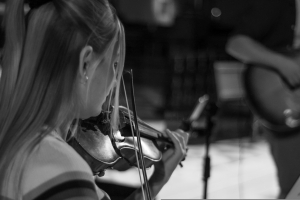Traditionally, a violin is a wooden box with four strings: G-D-A-E. But what about 5-string violins? Do they really exist?
Yes!
5-String violins are a fun way to explore additional range, which can open a variety of musical doors.
What is a 5 String Violin Called?
A 5 string violin is a type of violin that has an extra string tuned below the violin’s usual range. Some other facts to know about the 5 string violin include:
- It has a lower C string
- It combines the pitch ranges of the viola and violin
- This violin was first used in bluegrass music but is now popular in jazz, swing, and country
- These instruments are better for improvising because of their versatile and range
- It’s known for not being quite as squeaky-sounding as a viola
- The 5 string electric violin can help increas amplification and improve the sound quality of the instrument
5 string violin tuning can be tricky. The video below can help to show you the ropes:
What is the Difference Between a 4 String and 5 String Violin?
Can a violin have 5 strings? Absolutely. Here’s how it works – and how it differs from a typical 4 string violin.
The fifth string is generally added to the lower end of the range, borrowing the lowest string from the violin’s brother—the viola. The viola is a larger and lower-toned, but held the same way as a violin. The strings on a 5-stringed violin then become C-G-D-A-E. The 5-string violin can be acoustic or electric, but most models tend to be electric, but most models tend to be of the 5 string electric violin variety.
The addition of a 5th string to the violin allows the player to have a wider range of notes available for playing music across multiple genres. The player has the full range of both the violin and the viola. More notes on the bass (low) side of the instrument permit extra harmonization where not previously possible. In addition to different harmonies, playing double or triple stops becomes easier! (For more help with playing chords on your stringed instrument, see my previous blog post.
The performer is also able to access melodic lines written for viola, in addition to the standard violin repertoire. These pieces can include viola concertos and cello music transposed for viola. Accordingly, when working with a 5-string violin, it is helpful to have a functional knowledge of the alto clef, read by violists, as music printed for violin will not generally reference notes below the low G, the lowest open string. Music for viola, however, spans from the low open C string, and sometimes calls for the violist to read treble clef. Being able to read music in both clefs will be a big advantage and allow full access to all of the 5 strings.
Another benefit? When you learn how to play the 5 string violin, you can play 5 string violin sheet music as well as pieces written for either viola or violin. You’ll be much more versatile as a player!
How to Choose Between a 4 or 5 String Violin
Once you learn how to play both types of violin, there’s not much difference between the best 5 string electric violin and the best 4 string violin. However, there are certain circumstances in which choosing the 5 string might make more sense.
You might want to choosethis kind of violin if any of the following apply:
- You love playing the violin, but want the richness of the lower end more than the brightness of the top end
- Perhaps you like to cover guitar solos or guitar-based music on your violin
- You enjoy playing viola music in addition to violin songs
- When you enjoy playing gigs and frequently encounter songs with unfamiliar keys
- If you’re an improviser and composer and want to extend your range
The disadvantages are that this instrument:
- Has a wider neck, which can be uncomfortable to play for some people
- Possesses narrower spacings between springs
- Has less forgiving string crossings
Fortunately, most of these “cons” can be overcome with a little bit of practice and by taking violin lessons with an instructor who really knows what he or she is doing.
Is it Hard to Play a 5 String Violin?
Playing a 5-String violin is not without it’s challenges. Students will need to be even more aware of the placement of their bow on the string. Since the strings are much closer together than they would otherwise be on a standard violin or viola, it is easier to get a lot of unintentional noise by hitting the strings surrounding the one you are trying to play.
A 5-stringed violin player has options when looking for strings. Some companies that manufacture 5-stringed instruments also manufacture strings for the instruments. These manufacturers offer strings in a 5-string set. A player could also purchase a regular set of four viola strings and then separately buy a violin E string to add. Or, a player could purchase a regular set of violin strings and then add a viola C string.
Players of 5-stringed violins may also want to consider using a viola bow. Because viola strings are slightly thicker than violin strings, a violin bow may not be strong enough to create a full sound on a 5-string violin, especially if the player elects to use primarily viola strings. Viola strings require a bit more effort to pull, and the viola bow is more hefty and designed to do that.
How Much Does a 5-String Violin Cost?
The average violin costs about $2,000, with a bow costing another $500 or so.
If you want to get an electric 5 string violin, you’ll pay a bit more. These usually cost around $3,000, not counting a bow.
While you can always buy a used violin, remember – you get what you pay for! Don’t skimp on quality just to save a bit of money, as you’ll likely find that the sound quality suffers as a result.
Where to Find a 5 String Violin for Sale
You can buy these instruments at any music store, as well as online. Look for violins made of quality aged woods from reputable dealers, ideally those with some knowledge of the proper 5 string violin tuning.
As you can see, they do exist. The addition of the lower C string creates some additional considerations regarding technique and equipment for players. Despite these considerations and modifications, the experience of playing a 5-stringed violin is rewarding. 5-stringed violins open many musical doors!
About the Author:
Lisa has been playing stringed instruments for over 20 years. She teaches the violin, the viola, and the cell to students of all ages and levels. When Lisa isn’t teaching, she plays the violin with different local orchestras. She enjoys writing about the violin as much as she loves playing it, and likes to play a variety of genres including classical, rock, and fiddle. You can connect with Lisa at here TakeLessons profile.
Lisa Brunner







